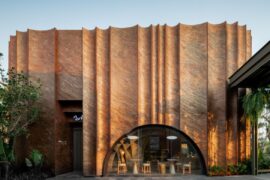“These projects can stand on the world stage against any other kind of health project, and be successful. They aren’t Aboriginal projects; they are architecture for a specific community, that meets and exceeds the brief,” shares Kaunitz Yeung founding principal, David Kaunitz on the INDE.Award winning Punmu and Parnngurr projects.

At Punmu and Parnngurr – remote towns located 1000km apart in Western Australia’s Pilbara region – Kaunitz Yeung Architecture recently completed two new health clinics that have garnered worldwide acclaim. Before putting pen to paper, architect David Kaunitz travelled across the Martu Lands multiple times, conversing with residents from both communities.
“The main client representative was Robbie Chibawe, the CEO of Puntukurnu Aboriginal Medical Services, and he came on almost every trip with me, because he saw these projects as an opportunity to engage with the communities,” Kaunitz recalls. “That meant I spent days in the car with him, which gave me a huge advantage, and we spent a lot of time at the front-end of the project, travelling and talking to people. That allows for all sorts of things to happen; it’s a kind of serendipity.
“Because we were there – and there regularly – we were meeting different people each time, and meeting the same people over and over again, ahead of the design phase,” Kaunitz says.
“At the end of the day, people are people,” he adds. “If you’ve ever been on a strata committee meeting, you know it’s almost impossible to get consensus. So we go into Aboriginal communities with an open mind and talk to people, working through the process step by step. It starts from first principles to get contextualised. And there are no cutting corners when it comes to community consultation,” he says.
“We want to produce different design solutions for each problem,” Kaunitz explains. “We don’t want to do the same thing over and over. I describe consultation as being like a spy, working out what people need, what they want, what will work, and it’s my job to use anything at my disposal to work that out.”
As for recent discussions about the decolonization of space, Kaunitz sees these projects not as Aboriginal architecture, but rather working to deliver the best outcomes for the communities they serve.
“What we do can be applied to any culturally-rich context, and I don’t like to get drawn into those discussions,” he says. “It’s not my place because I’m not Aboriginal. We are working community by community, helping each one, and each of them is very different.”
What sets KYA’s approach apart from most other firms is a desire to increase diversity across a range of measures – cultural, ethnicity, socio-economic background, age, gender – and a willingness to “open source the design process”, Kaunitz says.
“We are co-designing – we don’t mind using that term – so we are giving up some of the control,” he explains. “Most architects like to come up with a solution and convince the client, but we trust this process is going to lead to a better outcome.”
These two projects have collected multiple Australian and International awards – including accolades at the 2019 European Healthcare Design Awards in London, and The Wellness Space Award at this year’s INDE.Awards – and for Kaunitz, those accolades are significant.
“They show that these projects can stand on the world stage against any other kind of health project, and be successful,” he says. “They aren’t Aboriginal projects; they are architecture for a specific community, that meets and exceeds the brief.”
A searchable and comprehensive guide for specifying leading products and their suppliers
Keep up to date with the latest and greatest from our industry BFF's!

Vert, an innovative demountable pergola designed for urban greening, is reshaping the way we think about sustainability in urban architecture.

BLANCO launches their latest finish for a sleek kitchen feel.

In this candid interview, the culinary mastermind behind Singapore’s Nouri and Appetite talks about food as an act of human connection that transcends borders and accolades, the crucial role of technology in preserving its unifying power, and finding a kindred spirit in Gaggenau’s reverence for tradition and relentless pursuit of innovation.

Within the intimate confines of compact living, where space is at a premium, efficiency is critical and dining out often trumps home cooking, Gaggenau’s 400 Series Culinary Drawer proves that limited space can, in fact, unlock unlimited culinary possibilities.

The Heffron Centre in Maroubra, Sydney, stands as a testament to how authentic public art powered by collaborative project teams can transform urban spaces.

With her recent registration, Tiana Furner is among the first cohort of Indigenous women registered as architects in Queensland and indeed Australia.
The internet never sleeps! Here's the stuff you might have missed

Within the intimate confines of compact living, where space is at a premium, efficiency is critical and dining out often trumps home cooking, Gaggenau’s 400 Series Culinary Drawer proves that limited space can, in fact, unlock unlimited culinary possibilities.

IDIN Architects creates another spectacular project following its win in The Social Space category at the 2024 INDE.Awards.